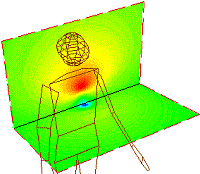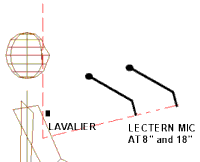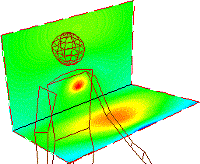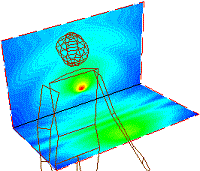
Main Page Related Pages One mic or two? Array Case Study A/V Systems Intelligibility Calculator Loudspeaker Directivity Sound System Design Speech Intelligibility Video Conference Facilities |
Microphone Smackdown! |
 Lavalier mic only |
 Lectern mic only |
Microphones obey the same laws of physics that loudspeakers do, and that means that a pair of spaced microphones that are summed to a common mix buss will generate the same sort of awful comb filtering that we saw in our examination of poorly configured loudspeaker arrays. This not only causes variations in sound quality, but also creates all sorts of lobes in the pickup pattern (just the inverse of what happens to loudspeakers), which create all sorts of opportunities for early onset of feedback.
Because the same laws of physics apply, the same modeling software used for calculating loudspeaker coverage can be used to predict the pickup pattern of combined microphones. The modeling results shown below are based on a cardioid lectern microphone and a cardioid lavalier microphone. We've projected the pickup pattern on a plane surface identified here as the talker's mouth plane. We've also painted the lectern/pulpit top with the pickup pattern to indicate where this combination will be sensitive to picking up reflected sound or paper shuffling noise on the lectern top.

Side view of talker, lav mic and lectern mic positions

Lectern mic 18" from Talker
500Hz pickup pattern
1000Hz pickup pattern
2000Hz pickup pattern
4000Hz pickup pattern
8000Hz pickup pattern
Lectern mic 8" from Talker
500Hz pickup pattern
1000Hz pickup pattern
2000Hz pickup pattern
4000Hz pickup pattern
8000Hz pickup pattern
We have shown the pickup sensitivity pattern for two variations in microphone spacing, one with the lectern mic about 18" from the talker's mouth, and the other with the lectern microphone about 8" from the talker's mouth. In both cases the lavalier microphone is about 8" below the talkers chin. The red and yellow colours indicate the highest microphone sensitivity, this is where this microphone combination is most sensitive to picking up sound. Note that there are all sorts of various shapes and variations in the pickup patterns. Some of these coincide with the lectern or pulpit top, which means that the microphone will be sensitive to picking up paper noise as well as reflections from this surface. Even the widely variable green areas are significant in terms of sensitivity to reflections creating feedback. Note how much worse the problem is as the two microphones get closer together.
You can hear this interference as people move and talk in front of the lectern microphone while wearing a lavalier mic, the very same comb filtering that you can hear moving across the coverage pattern of a misaligned multi-speaker cluster can be heard as you move the source across the pickup pattern of two microphones. Have a look at our examination of a pair of fixed microphones on a lectern.

Interference varies with distance
between talker and lectern mic
this is 2,000 Hz at 18" distance
16" distance
12" distance
9" distance
6" distance
3" distance
As bad as this configuration is for sound quality and uniform high frequency pickup, it is even worse for producing odd little hot spots in the pickup pattern that may coincide with loudspeaker system coverage lobes, reflections from nearby walls or ceilings, or even reflections from the eyeglasses of someone standing beside the talker. How many times have you seen a sound system take off into feedback when something changed beside or around the talker?
Note that you can make a lavalier and a lectern microphone work together if you implement a priority mixing arrangement so that when the lavalier microphone is in use it would duck the lectern microphone at least 6dB and as much as 10dB. This can make a significant difference in sound quality and especially in feedback prevention.
Check out our loudspeaker array article and our One Mic or Two article
![]()
